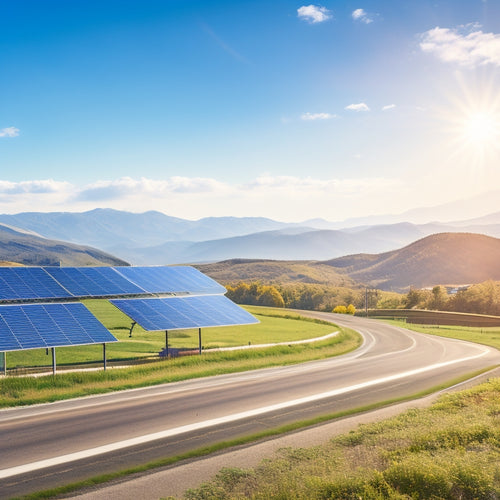
3 Best Energy Storage Systems for a Greener Tomorrow
Share
You'll find that three top energy storage systems for a greener tomorrow are solar batteries, thermal energy storage, and lithium-ion batteries. When selecting a system, consider key features like efficiency ratings, scalability options, and compatibility with existing infrastructure. Lithium-ion batteries stand out for their high energy density, long lifespan, and low self-discharge, making them a popular choice for residential and commercial use. With advancements in technology, you'll want to investigate the finer details of each option to ascertain the best fit for your needs, and by doing so, you'll uncover the perfect solution to power your sustainable future.
Overview
- Lithium-Ion Batteries offer high energy density, long lifespan, and low self-discharge, making them a preferred choice for efficient energy storage.
- Scalable energy storage systems like Flow Batteries provide flexible solutions for growing energy demands and are gaining popularity in the industry.
- Considering efficiency ratings, scalability options, and compatibility with existing infrastructure is crucial when selecting an energy storage system.
- Quality brands like Schneider Electric, OutBack Power, and Rolls-Surrette offer reliable and durable energy storage solutions for various applications.
- Advanced charger features like MPPT and multi-stage charging enhance energy harvesting and improve overall system performance in energy storage systems.
Top Energy Storage System Options
Your quest for a reliable energy storage system begins with understanding the top options available.
You're likely reflecting on solar batteries, which store excess energy generated from your solar panels during the day for use at night or during power outages. When assessing solar battery backup systems, it's vital to take into account key features such as capacity, voltage, and amp-hour ratings assessing system integration to meet your energy needs.
Another option is thermal energy storage, which involves heating or cooling a material to store energy for later use. This method is often used in conjunction with concentrated solar power systems.
You may also investigate other options like lead-acid batteries, lithium-ion batteries, and flywheel energy storage. Each has its advantages and disadvantages, so it's important to evaluate your energy needs and budget to determine the best fit.
Key Features to Consider Now
When selecting an energy storage system, several key features require careful consideration to confirm the chosen solution meets your specific needs. You'll want to evaluate the system's efficiency ratings, as this directly impacts your energy savings. Additionally, consider scalability options to guarantee the system can adapt to your growing energy demands.
| Feature | Considerations |
|---|---|
| Efficiency Ratings | Look for high ratings (e.g., 95%) for maximum energy savings |
| Scalability Options | Check if the system can be expanded or upgraded as needed |
| Compatibility | Confirm the system integrates with your existing infrastructure |
| Maintenance Requirements | Consider the frequency and complexity of maintenance tasks |
Best Battery Solutions Compared
Optimization of energy storage relies heavily on the choice of battery solution, as it directly impacts the overall performance and efficiency of the system.
You'll want to take into account lithium-ion batteries, which offer advantages such as high energy density, long lifespan, and low self-discharge rates. Additionally, selecting a charger with advanced features like MPPT and multi-stage charging can enhance energy harvesting and efficiency.
Furthermore, prioritizing brands known for quality and reliability, such as Schneider Electric, OutBack Power, and Rolls-Surrette, can guarantee a sturdy and long-lasting energy storage system.
However, flow batteries are also gaining traction, with innovations like vanadium-based systems providing scalable and flexible energy storage.
When comparing solutions, you should evaluate factors like capacity, depth of discharge, and charging/discharging rates. Additionally, reflect on the suitability of each technology for your specific application, whether it's residential, commercial, or industrial.
Frequently Asked Questions
Can Energy Storage Systems Be Used for Commercial Buildings?
You can greatly enhance commercial energy efficiency by installing energy storage systems in your building, allowing you to integrate renewable sources and reduce reliance on the grid, while also optimizing your energy usage and costs.
How Long Does It Take to Install an Energy Storage System?
You'll typically spend 2-6 months planning and 2-12 weeks executing an energy storage system installation, but be prepared to overcome installation challenges that can extend your installation timeline.
Are Energy Storage Systems Eligible for Government Incentives?
As you utilize the power of the future, you'll be thrilled to know that your energy storage system is eligible for federal tax incentives and state rebates, giving you a 21st-century enhancement to your wallet, courtesy of the government's nod to innovation.
Can I Use My Existing Solar Panels With a New Storage System?
You can integrate your existing solar panels with a new storage system, but first, you'll need to check their compatibility; verify the storage system's inverter matches your solar panel's voltage and power output to optimize energy harvesting and storage.
Will an Energy Storage System Increase My Property Value?
You'll likely see an enhancement in property value as a storage system increases your home's appeal to eco-conscious buyers, which a property appraisal will reflect, especially in areas with high market demand for sustainable living features.
Ready to Buy
As you're about to finalize your energy storage system, it's no coincidence that the top three options align perfectly with your values: a greener tomorrow. Lithium-ion, lead-acid, and flow batteries each bring unique strengths to the table, but all share a common goal - reducing our reliance on fossil fuels. By choosing the right system for your needs, you're not only securing a stable energy future but also contributing to a cleaner, healthier planet - a coincidence that's simply too good to ignore.
Related Posts
-

Is Switching to Green Energy Solutions Easy
Switching to green energy solutions isn't just easy; it's also beneficial. You can greatly cut utility costs and enjo...
-

Solar Powered Lights for Sustainable Home Decor
Solar-powered lights offer a stylish and eco-friendly way to enhance your home decor. They capture sunlight, converti...
-

Essential Hiking Lights for Safety and Fun
When you're hitting the trails, essential hiking lights are vital for safety and fun. A lightweight headlamp offers h...


